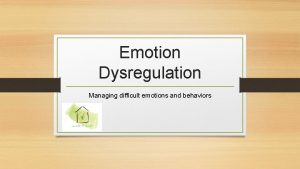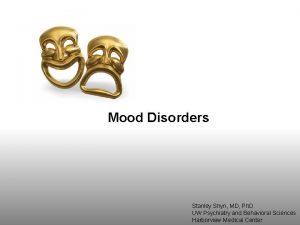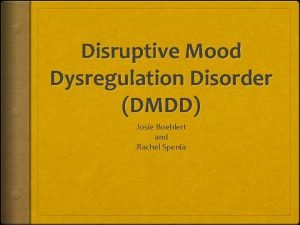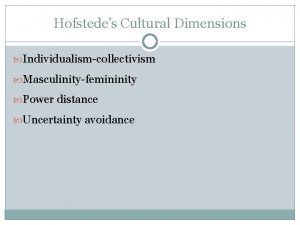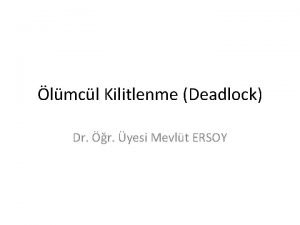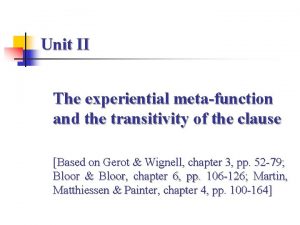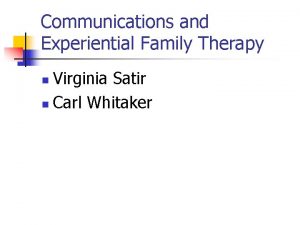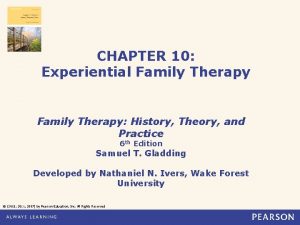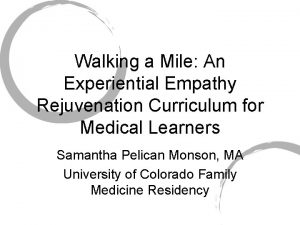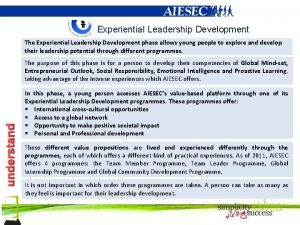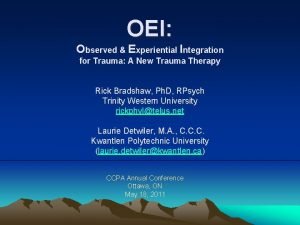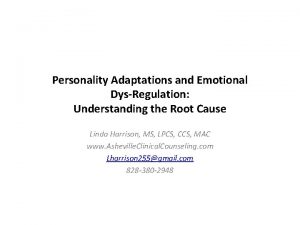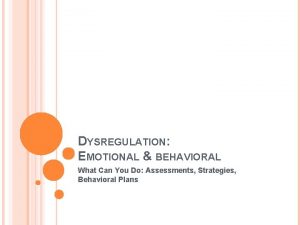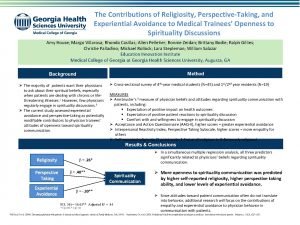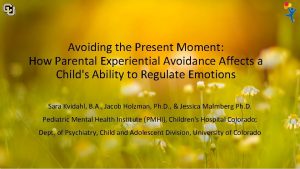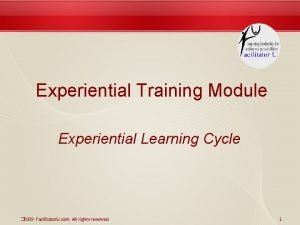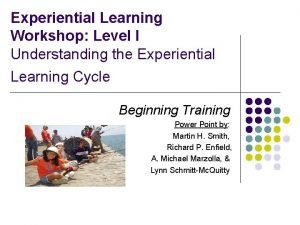EXPERIENTIAL AVOIDANCE AND EMOTIONAL DYSREGULATION AS THERAPEUTIC DIMENSIONS





















- Slides: 21

EXPERIENTIAL AVOIDANCE AND EMOTIONAL DYSREGULATION AS THERAPEUTIC DIMENSIONS IN ALCOHOL USE DISORDER TREATMENT: findings based on 3 -months Dialectical Behavior Therapy Skills Training Marco Cavicchioli (1 -2), Mariagrazia Movalli (1 -2), Francesco Massa (2), Pietro Ramella (2), Cesare Maffei (1 -2) (1) University Vita-Salute San Raffaele, Milan; (2) Department of Clinical Psychology, San Raffaele Hospital, Milan

WHY FOCUSING ON EA It was postulated and proved that EA represents a functional dimensional in several psychopathological disorders (for a review see: Chawla & Ostafin, 2007; Hayes et al. , 1996), including Substance Use Disorders (SUDs). In clinical and experimental research, there is a working in progress discussion about the relation between EA and emotion regulation: EA REPRESENTS A SPECIFIC FORM OF EMOTION REGULATION EA IS A COMMON PATHOLOGICAL FUNCTION OF PARTICULAR EMOTIONAL REGULATION STRATEGIES (Hoffman & Asmundson, 2008) (Boulanger, Hayes & Pistorello, 2010)

WHY FOCUSING ON EA AND DIFFICULTIES IN EMOTION REGULATION IN SUDS Empirical research showed how EA was: related to some clinical aspects of SUDs (Baker et al. , 2004; Levin et al. , 2012; Stewart, Zvolensky & Eifert, 2002) a mediator of relationship between some different forms of psychological distress and substance use (Bordieri et al. , 2014; Levin et al. , 2012; Stewart, Zvolensky & Eifert, 2002) Specific difficulties in emotion regulation were found in several SUDs: • deficits in tolerating and accepting emotions (e. g. Berking et al. , 2011; Bonn-Miller et al. , 2008; ) • difficulty in impulse control when experiencing negative emotions (e. g. Fox et al. , 2007; 2008) • believes there is little to do when one experiences negative emotions (Wilcox & Adinoff, 2015)

WHY DBT SKILLS TRAINING IN TREATMENT OF ALCOHOL USE DISORDER Dialectical Behavior Therapy (DBT) is a manualized psychological treatment originally developed to reduce maladaptive behaviors related to emotional dysregulation in Borderline Personality Disorder (BPD) (Linehan, 1993) Several randomized controlled trials (RCTs) have demonstrated that DBT is an effective treatment for BPD (for a review see: Leichsenring et al. , 2011; Panos et al. , 2013) Research on DBT efficacy supports the hypothesis that this treatment can be useful in other mental disorders related to emotional dysregulation (Linehan et al. , 2007), including SUDs (Axlerod et al. , 2011; Harned et al. , 2008; Linehan et al. , 1999, 2002; van den Bosch et al. , 2002, 2005; Linehan & Dimeff, 2008)

WHY CONSIDERING EA IN DBT Even though EA is not considered the primary hypothesized pathological process in DBT model, some studies investigated the role of this dimension in DBT outcomes and it was considered as a secondary outcome of DBT programs. Specifically: EA represented a therapeutic interference factor in DBT programs (Berking et al. , 2009; Rüsch et al. , 2008) DBT showed a specific effect, compared with CBT, in improving emotional expression and in reducing EA in BPD treatment (Neacsiu et al. , 2014)

THE ROLE OF EA ON DBT-ST TREATMENT OUTCOMES FOR AUD HAS NOT BEEN PREVIOUSLY REPORTED

AIMS OF THE STUDY This study aims to: 1 show primary treatment outcomes abstinence maintenance consecutive days of abstinence (CDA) alcohol addiction severity 2 assess the improvement of EA and SUDs-related domains of emotional dysregulation during the treatment 3 test the predictive role of EA on alcohol/substance use outcome consecutive days of abstinence (CDA) 4 evaluate the mediating effect of EA on relationship existing between SUDs-related difficulties in emotional regulation and abstinence maintenance

RESULTS: SAMPLE 110 AUD patients were consecutively admitted to 3 -month DBT-ST program as stand-alone treatment 86 (78. 2%) patients completed the program. 4 (3. 6%) subjects did not conclude the intensive phase. 20 (18. 2%) subjects did not conclude the post-intensive phase. Abstinence maintenance was assessed by random weekly toxicological screening (e. g. alcohol and other drugs) POST-INTENSIVE PHASE 8 WEEKS (TWICE A WEEK) 4 WEEKS (5 TIMES A WEEK) 1 2 3 4 5 6 7 8 9 10 11 12 110 86 PATIENTS 4 20

RESULTS: PRIMARY TREATMENT OUTCOMES The 83. 7% completers maintained abstinence at the end of program CDA mean was 97. 85 (SD = 38. 19) among subjects who completed the treatment Perceived alcohol addiction severity (SPQ alcohol ) significantly decrease during the treatment independently of baseline levels [t(84) = -18. 35; p <. 001] d = -1. 94 (-2. 31 - -1. 58) ITT analysis supported the previous findings [t(108) = -10. 25; p <. 001] d = -1. 01 (-1. 32 - -. 69)

RESULTS: EA AND SUD-RELATED DIMENSIONS OF ED 30 20 10 0 25 25 20 20 15 10 5 0 40 35 DERS Strategies AAQ-II 40 30 DERS Impulse 50 DERS Non-aceeptance 60 30 25 20 15 10 5 0 beginning of treatment end of treatment

RESULTS: PREDICTIVE ROLE OF EA ON CDA ITT results (N=110) CDA R 2 Lineare = 0, 040 y=1, 14 E 2+-0, 75*x AAQ-II at the beginning of treatment В = -. 20, p <. 05; R 2 =. 04

RESULTS: THE MEDIATING ROLE OF EA ON PRIMARY OUTCOMES ITT results (N=110) 45 40 35 lapsed abstinent 30 25 20 beginning of treatment end of treatment *

RESULTS: THE MEDIATING ROLE OF EA ON PRIMARY OUTCOMES 19 trends in DERS Impulse [F(1, 106) = 2, 16; ns] and DERS Strategies [F(1, 106) = 2, 72; ns] between lapsed and abstinent patients the improvement in ability to accept and tolerate negative emotions remained the unique emotion regulation domain that was significantly related to abstinent maintenance DERS Non-acceptance pre-post change of EA explained different 17 15 13 lapsed 11 abstinent 9 7 beginning of treatment end of treatment

RESULTS: THE MEDIATING ROLE OF EA ON PRIMARY OUTCOMES 16 pre-post change of EA explained different the improvement in ability to accept and tolerate negative emotions remained the unique emotion regulation domain that was significantly related to abstinent maintenance 14 DERS Impulse trends in DERS Impulse [F(1, 106) = 2, 16; ns] and DERS Strategies [F(1, 106) = 2, 72; ns] between lapsed and abstinent patients 12 lapsed 10 abstinent 8 6 beginning of treatment end of treatment

RESULTS: THE MEDIATING ROLE OF EA ON PRIMARY OUTCOMES 28 pre-post change of EA explained different the improvement in ability to accept and tolerate negative emotions remained the unique emotion regulation domain that was significantly related to abstinent maintenance DERS Strategies trends in DERS Impulse [F(1, 106) = 2, 16; ns] and DERS Strategies [F(1, 106) = 2, 72; ns] between lapsed and abstinent patients 26 24 22 20 18 lapsed 16 abstinent 14 12 10 beginning of treatment end of treatment

DISCUSSION DBT-ST for AUD showed promising results in relation to primary outcomes such as treatment retention, abstinence maintenance and alcohol addiction severity large improvements in EA and specific SUD-related difficulties in emotion regulation were observed during the treatment These results are consistent with DBT’s emphasis on reducing emotional suppression/avoidance as well as on improvement emotional modulation using skills taught during the DBT-ST: MINDFULNESS SKILLS DISTRESS TOLERANCE SKILLS ACCEPTANCE SKILLS OPPOSITE ACTION SKILLS PROBLEM SOLVING SKILLS

DISCUSSION EA represented an early predictor of primary treatment outcome greater improvement in EA and in SUD-related emotional dysregulation dimensions were related to abstinence maintenance during the treatment changes in EA explained the relationship existing between improvements in impulse control when experiencing negative emotions and learning of flexible emotion regulation strategies with abstinence maintenance LAPSE IN SUBSTANCE USE REPRESENTS A DYSFUNCTIONAL EMOTION REGULATION STRATEGY, WHICH HAS THE FUNCTION TO AVOID OR ALTER AVERSIVE EXPERIENCES

DISCUSSION THE ABILITY TO ACCEPT AND TOLERATE NEGATIVE EMOTIONS IN ADDITION TO THE DEVELOPMENT OF A WILLINGNESS STANCE TOWARD UNWANTED EXPERIENCES MIGHT REPRESENT CORE THERAPEUTIC DIMENSIONS IN AUD TREATMENT

LIMITATIONS The absence of a control treatment condition (e. g. other treatments, waiting list): • we can not definitely attribute the improvement of EA/SUD-related ER strategies to a specific effect of DBT-ST program • the reduction of EA and difficulties in emotion regulation might be explained by factors that are shared with other third wave cognitive therapies, that showed promising results in SUDs treatment, such as ACT and MBRP

FUTURE PERSPECTIVES Additional clinical controlled trials are recommended to prove the specificity of DBT in reducing EA, as well as further process-outcome studies are necessary in order to understand which aspects of DBT intervention might have a better effect on EA decrease. Follow-up studies should be carried out to evaluate the stability of EA and emotional dysregulation levels reached at the end of treatment and their role in long-term relapse prevention.

THANK YOU FOR YOUR ATTENTION! Any questions?
 Ruth anne rehfeldt
Ruth anne rehfeldt Emotional dysregulation
Emotional dysregulation Bdt emotional dysregulation
Bdt emotional dysregulation Dmdd diagnosis
Dmdd diagnosis Dmdd medication
Dmdd medication Mood dysregulation disorder
Mood dysregulation disorder Council for adult and experiential learning
Council for adult and experiential learning Low power distance คือ
Low power distance คือ Laray m. barna (1997)
Laray m. barna (1997) Deadlock prevention avoidance and detection
Deadlock prevention avoidance and detection Deadlock detection prevention and avoidance
Deadlock detection prevention and avoidance Deadlock prevention vs avoidance
Deadlock prevention vs avoidance Transitivity
Transitivity Experiential family therapy satir
Experiential family therapy satir In experiential readiness motivation is also known as
In experiential readiness motivation is also known as Experiential family therapy
Experiential family therapy Ninian smarts model
Ninian smarts model David kolb's learning cycle pdf
David kolb's learning cycle pdf Experiential empathy
Experiential empathy Experiential metafunction
Experiential metafunction Experiential leadership development
Experiential leadership development Audrey cook therapist vancouver
Audrey cook therapist vancouver

